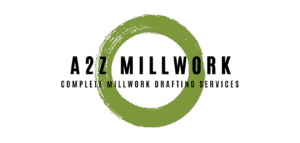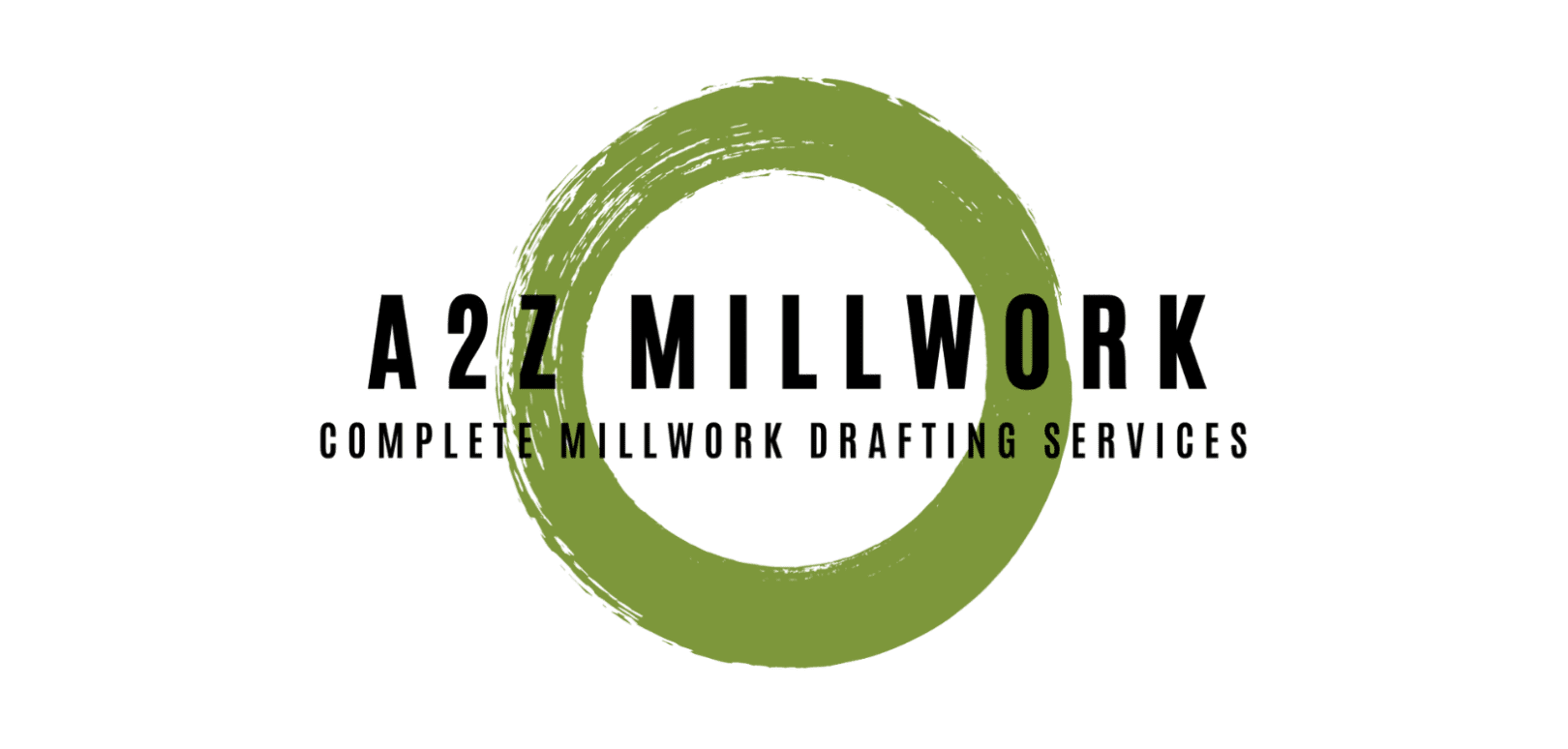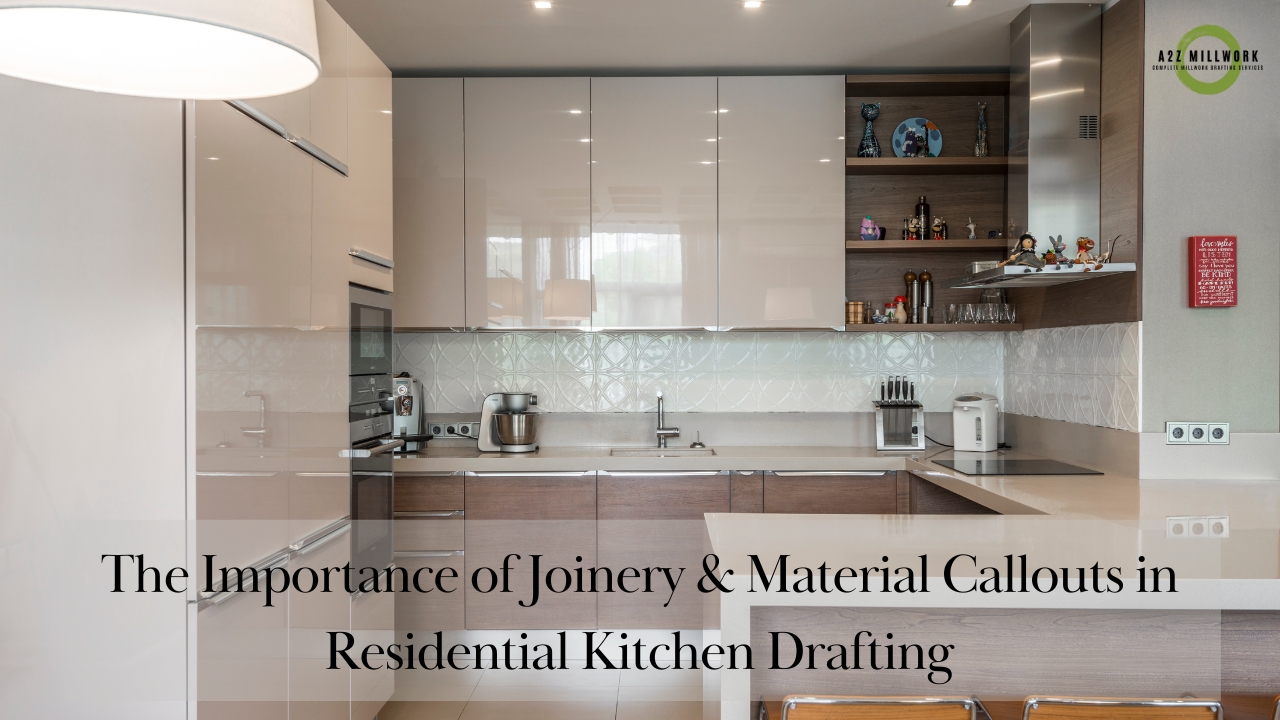Introduction
In the world of residential kitchen design, precision isn’t a luxury—it’s a necessity. Joinery and material callouts are not just technical details; they’re the backbone of functional, durable, and aesthetically pleasing kitchens. For architects, designers, and contractors across the USA, understanding and specifying these elements correctly during drafting prevents installation errors, cutdowns on costly revisions, and ensures homeowner satisfaction.
In this comprehensive guide, we explore why joinery and material callouts are critical in kitchen shop drawings, supported by topic clusters that enhance usability, optimize workflows, and improve overall kitchen performance. We’ll also spotlight A2Z Millwork Design LLC, a trusted drafting partner committed to delivering excellence.
What Are Joinery & Material Callouts?
Joinery Details:
Joinery refers to how wood components are connected. Common techniques include dovetail, mortise and tenon, dowel, biscuit, and tongue‑and‑groove joints. Each has specific structural and visual benefits.
- Dovetail – signature joint for drawers; strong and durable
- Mortise & tenon – used in frames for added strength
- Biscuit/Domino – popular for aligning panels in modern cabinetry
Material Callouts:
Callouts specify what material goes where—e.g., “3/4″ maple veneer plywood, sealed.” Clear material specs eliminate guesswork and ensure contractors order, cut, and assemble correctly.
Why These Matter
- Precision – avoids field adjustments or misalignments.
- Durability – proper joints enhance structural integrity and longevity.
- Appearance – visible corners (like dovetails) reflect craftsmanship.
- Consistency – uniform materials ensure smooth application of finishes and reduce callbacks.
How Joinery Enhances Kitchen Durability and Functionality
Structural Integrity
High‑quality joinery like dovetail and mortise & tenon withstand daily wear and cabinetry stress, greatly reducing sagging or separation over time.
Smooth Operation
Precision joinery allows drawers to glide easily, cabinet doors to stay aligned, and hardware to function without strain—elevating the experience.
Craftsmanship Aesthetic
In upscale kitchen environments, fine joinery is a visible marker of quality. It adds value and appeal, especially in premium or custom kitchens.
Environmental Considerations
Precise woodworking techniques reduce material use and waste, promoting sustainability
Why Material Callouts Are Not Optional
Ensuring Durability
Kitchen environments are exposed to moisture and heat. Specifying the right materials—e.g., moisture-resistant plywood for sink cabinets—prevents warping.
Meeting Building Codes
Different areas require UL-rated, fire-retardant, or low-VOC materials. Proper callouts ensure compliance and smoother inspection cycles.
Client Expectations
High-end clients notice inconsistencies. Detailed callouts prevent using mismatched species or grades, maintaining aesthetic harmony.
Optimizing Production
CNC fabricators rely on precise material specs to optimize cutting and nesting—reducing waste and speeding up production cycles.
Joinery & Callouts in Kitchen Drafting—Best Practices
Clear Joint Representation
Include detailed maps of joinery types on drawings. E.g.:
- Drawer boxes – ½″ baltic birch plywood with dovetail joints
- Frame faces – mortise & tenon at all structural intersections
Layered Material Information
Use layered CAD files to display sheets, labels, finishes, and key joint areas separately, making references and CNC file export cleaner.
Visual Callout Tags
Use tags pointing to join types and material details. Bonus: include shared legends for quick reference by installers and site supervisors.
Include Section & Elevation Details
Plan views are not enough. Section drawings showing end grain and edge banding provide clarity in joint and material transitions .
Avoiding Common Failures via Critical Callouts
- Weak joints – Avoid butt joints in load-bearing cabinetry by specifying reinforced joinery.
- Ill-suited materials – Don’t use low-grade plywood for wet zones; call out proper materials.
- Unclear labeling – Complex kitchens need consistent part numbering and material notes.
- Ignored edge details – Highlight edge banding and veneer direction visually to maintain consistent appearance.
Integrating Joinery & Material Callouts with CNC Drafting
CNC-driven Drawing Benefits
When carefully integrated, callouts enable CNC machines to produce precisely sized, pre drilled components with accurate labeling—reducing production time and errors.
Software Capabilities
Using tools like AutoCAD, Microvellum, and Cabinet Vision, designers embed joinery and material data directly into CAD models, which then feed into CNC workflows.
Field Verification
CNC tagging ensures that parts receive labels matching shop and site plans. Installers can match parts and materials quickly.
Case Study – Kitchen Remodel by A2Z Millwork Design LLC
Project Overview
A luxury renovation in Texas tasked A2Z with designing a 200‑sq‑ft kitchen: maple cabinetry, pocket‑profile edge banding, floating shelves, and a live-edge island.
Drafting Execution
- Used mortise & tenon for face frame cabinets.
- Dovetail drawer boxes in alder plywood.
- Specified reclaimed walnut for island top.
- Included edge banding and veneer direction callouts.
Collaboration & Delivery
- Drafts reviewed with contractor, carpenter, and architect in the initial RFI stage.
- CNC files generated with embedded joinery details and part labels.
- Onsite assembly matched plans precisely—no rework required.
Outcome
- Installation completed 3 days before schedule, 20% under budget.
- Clients expressed satisfaction at even grain matching and tight joints.
Why U.S. Kitchen Builders Trust A2Z Millwork Design LLC
- Expertise in Joinery Specification
A2Z understands joint applications and selects the most appropriate method for each use case. - Material Knowledge
Deep experience in U.S. material sourcing ensures project-specific suitability and compliance. - Advanced CAD & CNC Integration
Using AutoCAD, Cabinet Vision, and Microvellum, A2Z ensures drawings are CNC-ready and error-free. - Collaborative Workflow
A2Z coordinates closely with architects and contractors to align joinery callouts and material choices. - Track Record of Quality
Clients consistently report reduced RFIs, faster installs, and cleaner project handovers.
Conclusion
Precise joinery and material callouts are not optional—they’re essential for structural robustness, smooth operation, aesthetic excellence, and professional credibility. For U.S. residential kitchen projects, these drawing elements ensure durable, functional, and visually compelling results.
A2Z Millwork Design LLC excels at delivering detailed drafting packages that encompass every joint, material, and edge—backed by workflows compatible with CNC production and field installation. So, next time you want a kitchen that stands the test of time, start with smart drafting.
Partner with A2Z Millwork Design LLC—where joinery mastery meets modern CNC precision



